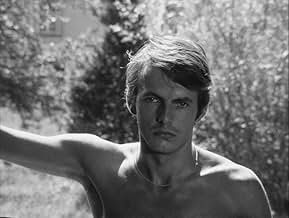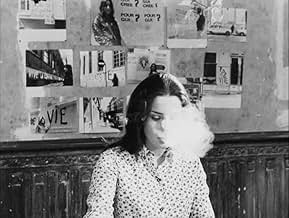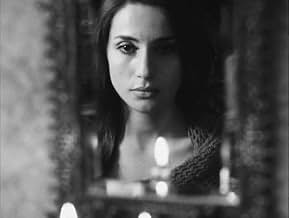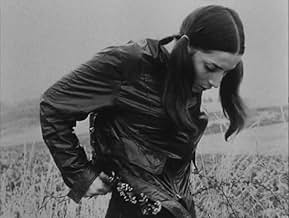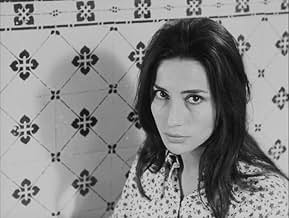Aggiungi una trama nella tua linguaAfter the May 1968 uprisings in France, a young woman named Graziella moves to a remote house in the Norman countryside to contemplate the events.After the May 1968 uprisings in France, a young woman named Graziella moves to a remote house in the Norman countryside to contemplate the events.After the May 1968 uprisings in France, a young woman named Graziella moves to a remote house in the Norman countryside to contemplate the events.
- Regia
- Sceneggiatura
- Star
Trama
Lo sapevi?
- QuizThe film has no written credits. A voice-over (of filmmaker Marcel Hanoun himself) gives all the information (title of the film, cast and crew, musical references) at the beginning and at the end of the film.
Recensione in evidenza
Another unknown Hanoun film, the first of its four seasons. Shot in a week with limited resources and in an almost amateurish manner, it is a small film of great interest due to the cinematographic ideas it contains.
Close to the world of the nouvelle vague, although with a transcendental tone very much like the first Bresson (the debt is recognized in the quote to the little donkey Baltazhar).
An attractive young woman has ended her relationship with an attractive young man and decides to "find herself" during the summer in a lonely house in the middle of the French countryside. The film is a collage of images and themes as she writes letters to a friend, thinks about her old boyfriend, caresses herself naked in bed, runs through the garden, tells us about the music she hears and the books she reads, worries about political news and remember quotes from Hegel. It is therefore very much like a small cinematographic diary.
The aim is to give structure to this hodgepodge in a purely cinematographic manner and not through a standard written script (a traditional plot, the development of a character...). This apparently translates into shaping it through rhythm, montage, repetition of images and cinematographic techniques (the use of photography alternating with the moving image, certain uses of voice-over and its relationship with the image... ), but above all in the tireless and cyclical repetition of the same motifs, as if it were a musical composition (which ultimately resorts to somewhat narrative elements).
There is no progress until the abrupt ending, and the film could continue for another hour insisting on the same motifs, or end half an hour earlier. The duration does not imply a gradual advance, but simply a greater familiarization with the motifs that it repeats and weaves over and over again.
The young protagonist is a beautiful model, but Hanoun abuses interesting poses, affected looks into space, with too much of a "rural vogue" tone. Naturally, she is a young progressive intellectual, committed, liberated, who takes photographs on the street in front of revolutionary graffiti on the walls, who explains to us the dangers of an incomplete proletarian revolution and who sends us a string of philosophical quotes.
In the first scenes she introduces us to the motifs that will be repeated throughout the film: resting in the countryside, memories of the police attacks in May '68, communist news, meetings with her ex-boyfriend, Kleist's book that she is reading, the music records she listens to, the letter she writes by hand to her friend, the texts she writes on type... and throughout the film these motifs will be developed successively: long quotes from Michael Kohlhass, Monteverdi and the baroque to Liszt that will play successively during the film, her German friend reading the letter she writes to him, the naked girl in bed remembering the sexual encounters with her boyfriend, many political and poetic quotes, her wanderings through the wheat fields and the neighbors' farms, notes on the Russian invasion of Czechoslovakia.
There is, as in much French (and not only French) cinema of the time, a whiff of pedantry that is about to ruin the film and a lot of affectation, a typically (and ridiculously) cool vision of May '68, and of course baroque music to accompany the images (a Magnificat by Monteverdi...exactly like Bresson in his Mouchette); but at the same time there is a pleasant humility (far from the bombastic Godard) that at times gives us a certain sense of inventiveness that is less inconsequential and gratuitous than in much nouvelle vague. Above all, there are many interesting ideas and an innovative formal treatment that tries to explore more purely cinematographic paths than in the usual commercial cinema, although we struggle to find the necessary rigor to make it totally satisfactory.
It is difficult to give an assessment of a film that appears to us as a very small artistic object that is as purely cinematographic as the result could be improved.
Close to the world of the nouvelle vague, although with a transcendental tone very much like the first Bresson (the debt is recognized in the quote to the little donkey Baltazhar).
An attractive young woman has ended her relationship with an attractive young man and decides to "find herself" during the summer in a lonely house in the middle of the French countryside. The film is a collage of images and themes as she writes letters to a friend, thinks about her old boyfriend, caresses herself naked in bed, runs through the garden, tells us about the music she hears and the books she reads, worries about political news and remember quotes from Hegel. It is therefore very much like a small cinematographic diary.
The aim is to give structure to this hodgepodge in a purely cinematographic manner and not through a standard written script (a traditional plot, the development of a character...). This apparently translates into shaping it through rhythm, montage, repetition of images and cinematographic techniques (the use of photography alternating with the moving image, certain uses of voice-over and its relationship with the image... ), but above all in the tireless and cyclical repetition of the same motifs, as if it were a musical composition (which ultimately resorts to somewhat narrative elements).
There is no progress until the abrupt ending, and the film could continue for another hour insisting on the same motifs, or end half an hour earlier. The duration does not imply a gradual advance, but simply a greater familiarization with the motifs that it repeats and weaves over and over again.
The young protagonist is a beautiful model, but Hanoun abuses interesting poses, affected looks into space, with too much of a "rural vogue" tone. Naturally, she is a young progressive intellectual, committed, liberated, who takes photographs on the street in front of revolutionary graffiti on the walls, who explains to us the dangers of an incomplete proletarian revolution and who sends us a string of philosophical quotes.
In the first scenes she introduces us to the motifs that will be repeated throughout the film: resting in the countryside, memories of the police attacks in May '68, communist news, meetings with her ex-boyfriend, Kleist's book that she is reading, the music records she listens to, the letter she writes by hand to her friend, the texts she writes on type... and throughout the film these motifs will be developed successively: long quotes from Michael Kohlhass, Monteverdi and the baroque to Liszt that will play successively during the film, her German friend reading the letter she writes to him, the naked girl in bed remembering the sexual encounters with her boyfriend, many political and poetic quotes, her wanderings through the wheat fields and the neighbors' farms, notes on the Russian invasion of Czechoslovakia.
There is, as in much French (and not only French) cinema of the time, a whiff of pedantry that is about to ruin the film and a lot of affectation, a typically (and ridiculously) cool vision of May '68, and of course baroque music to accompany the images (a Magnificat by Monteverdi...exactly like Bresson in his Mouchette); but at the same time there is a pleasant humility (far from the bombastic Godard) that at times gives us a certain sense of inventiveness that is less inconsequential and gratuitous than in much nouvelle vague. Above all, there are many interesting ideas and an innovative formal treatment that tries to explore more purely cinematographic paths than in the usual commercial cinema, although we struggle to find the necessary rigor to make it totally satisfactory.
It is difficult to give an assessment of a film that appears to us as a very small artistic object that is as purely cinematographic as the result could be improved.
- Falkner1976
- 21 mag 2024
- Permalink
I più visti
Accedi per valutare e creare un elenco di titoli salvati per ottenere consigli personalizzati
Dettagli
- Data di uscita
- Paese di origine
- Sito ufficiale
- Lingue
- Celebre anche come
- Лето
- Azienda produttrice
- Vedi altri crediti dell’azienda su IMDbPro
- Tempo di esecuzione1 ora 22 minuti
- Colore
- Mix di suoni
Contribuisci a questa pagina
Suggerisci una modifica o aggiungi i contenuti mancanti


